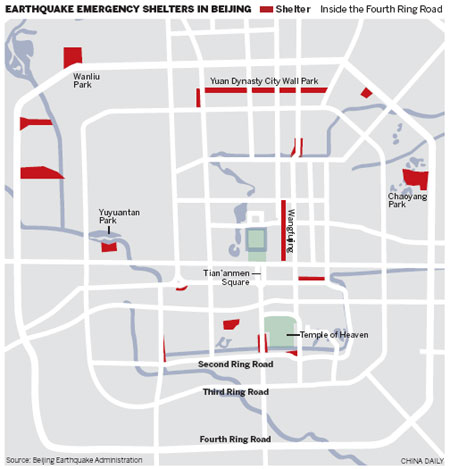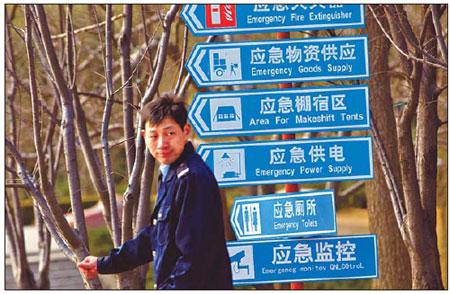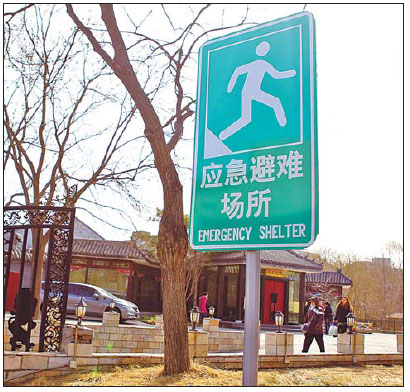Life
Where to go when the city has a quake
By Wang Wei (China Daily)
Updated: 2011-03-24 07:55
 |
Large Medium Small |

|
Signs at the entrance to Yuan Dynasty City Wall Relics Park, which is one of the shelters in the capital, provide useful information to residents in case an emergency strikes. [Photo/China Daily] |
|
One of the signs showing a running person that indicates one of the emergency shelters. |
Places of refuge spread throughout city in case disaster strikes.
The 700-year-old Yuan Dynasty City Wall Relics Park is an oasis of serenity in a bustling city - and it would become a safe haven if Beijing were to be jostled by a catastrophic disaster, such as an earthquake.
The park is the country's first quake emergency shelter and one of 33 scattered throughout the capital.
The shelter covers 670,000 square meters and can accommodate up to 190,000 people, providing 1.5 to 2 square meters of space per person, according to regulations.
The shelter is divided into different zones. A green rectangular sign printed with the image of a running person stands near the park's entrance, indicating the emergency shelter's location and distance.
Areas for power supplies, drinking water sources, medical treatment and makeshift tents are carefully marked to guide people in the event of an emergency.
The most distinguishable site is the airfield, a 100-square-meter plateau painted with a red "H" inside a circle and framed by walls.
Sub-district governments often distribute leaflets promoting earthquake response activities so residents can learn about the shelter and its functions.
Retiree Huang Hongming walks in the park every morning.
The 55-year-old knows the park is an emergency shelter because a map showing the fastest routes to safety in case of an emergency is posted in her apartment complex.
"Most people in the neighborhood know about the shelter," she says.
"It's comforting to know there is a place to go if disaster strikes."
Most of Beijing's 33 shelters are parks spread across 14 districts and two counties.
The largest is the northern area of Chaoyang Park, which covers 1,2 million square meters and can accommodate 115,000 people. The smallest - at 0.62 sq m - is the greenbelt outside of the Shencang in Xiannong Temple in Xicheng district.
Every shelter is outfitted with electronic generators, water pumps and other facilities able to provide refuge seekers' daily needs for at least a week, Zhang Jingjun, an Beijing Earthquake Administration engineer, said.
"If people feel an earthquake, they should hide in the nearest safe place rather than trying to escape through windows or elevators," he said.
"Once the tremor stops, people should immediately run to the shelters to avoid (being at risk during) aftershocks."
Earthquake authorities are closely monitoring seismic activity in Beijing, as the city was once jolted by a major tremor, Zhang said.
The worst was an 8.0-magnitude tremor that occurred on Sept 2, 1679. Historical records say at least 2,677 people died, and large cracks appeared in the ground.
Ten aftershocks rattled the city over the following month.
Municipal authorities have pledged to build hundreds of emergency shelters over the next five years.
| 分享按钮 |

